



Find all of your laboratory and workplace safety supplies at Safety Emporium!
 Phlegm |
 Glossary Index |
 Pneumoconiosis |
| MSDS Topics |
Free Sites | FAQ's | Regulations | Glossary | Software | Suppliers |
| Books | Forum | Poll | Fun stuff | Quiz | Store | |
| Understand your MSDS with the MS-Demystifier | Search ALL our MSDS info | |||||
Pictograms are pictorial symbols for a word, phrase, object, or concept. Some familiar examples are the silhouette of man or woman to indicate the location of a restroom and the "No Smoking" signs that have the image of a lit cigarette with a red slash and circle.
The word pictograph is a variant of "pictogram" and is sometimes used interchangeably. There are differences between the two terms, however they appear finely nuanced depending on many factors and as far as we know there is no clearcut differentiation. Some interpret pictograph to apply specifically to graphical data or even to rock drawings (which are more accurately described as petroglyphs).
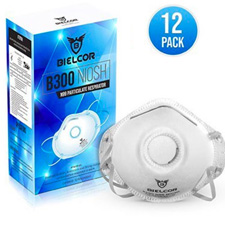
Get your PPE such as NIOSH-approved N99 masks and face shields from Safety Emporium.
Paragraph (c) of 29 CFR 1910.1200, the OSHA Hazard Communication Standard, the primary regulation concerning (material) safety data sheets in the US, defines a pictogram as "a composition that may include a symbol plus other graphic elements, such as a border, background pattern, or color, that is intended to convey specific information about the hazards of a chemical. Eight pictograms are designated under this standard for application to a hazard category."
Appropriate pictograms are a required label element on any material shipped from a chemical manufacturer, importer or other "responsible party". Appendix C of the Standard explains the required label elements and paragraph C.2.3 specifically states:
C.2.3.1 Pictograms shall be in the shape of a square set at a point and shall include a black hazard symbol on a white background with a red frame sufficiently wide to be clearly visible. A square red frame set at a point without a hazard symbol is not a pictogram and is not permitted on the label.
C.2.3.2 One of eight standard hazard symbols shall be used in each pictogram. The eight hazard symbols are depicted in Figure C.1. A pictogram using the exclamation mark symbol is presented in Figure C.2, for the purpose of illustration.
C.2.3.3 Where a pictogram required by the Department of Transportation under Title 49 of the Code of Federal Regulations appears on a shipped container, the pictogram specified in C.4 for the same hazard shall not appear.
Note: The Standard does not require the use of pictograms on the SDS itself, although most responsible manufacturers will do so to preserve the correspondence between a substance's SDS and label.
The 8 GHS pictograms incorporate 16 physical, 10 health, and 3 environmental hazards. The hazard classification process that is used to assess the chemical may indicate the use of a given pictogram more than once, however, the label should bear no more than one instance of each pictogram (see Appendix C of the HazCom Standard, paragraph C.2.3.1), and each pictogram should be sufficiently large to be "clearly visible" (Appendix C, paragraph C.4).
| Pictogram and Descriptor |
Hazard Class and Category | Safety Emporium Item # |
|---|---|---|
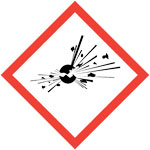 Exploding Bomb |
Unstable explosives Explosives: Division 1.1, 1.2, 1.3, and 1.4 Self-reactive substances and mixtures: Types A and B Organic peroxides: Types A and B |
03602 |
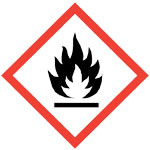 Flame |
Flammable gases: category 1 Flammable aerosols: categories 1 and 2 Flammable liquids: categories 1, 2 and 3 Flammable solids: categories 1 and 2 Self-reactive substances and mixtures: Types B, C, D, E, and F Pyrophoric liquids: category 1 Pyrophoric solids: category 1 Self-heating substances and mixtures: categories 1 and 2 Substances and mixtures, which in contact with water, emit flammable gases: categories 1, 2, and 3 Organic peroxides: Types B, C, D, E, and F |
03600 |
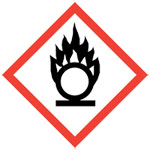 Flame Over Circle |
Oxidizing gases: category 1 Oxidizing liquids: categories 1, 2, and 3 |
03601 |
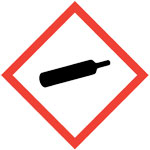 Gas Cylinder |
Gases under pressure, including compressed gases, liquified gases, refrigerated liquified gases, and dissolved gases. |
03604 |
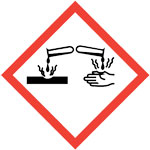 Corrosion |
Corrosive to metals: category 1 Skin corrosion: categories 1A, 1B, and 1C Serious eye damage: category 1 |
03603 |
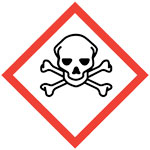 Skull and Crossbones |
Acute toxicity (oral, dermal or inhalation): categories 1,2,3 |
03605 |
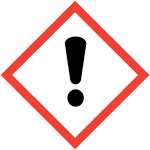 Exclamation Mark |
Acute toxicity (oral, dermal or inhalation): category 4 Skin irritation: category 2 Eye irritation: category 2 Skin sensitization: category 1 Specific Target Organ Toxicity (Single exposure): category 3 |
03608 |
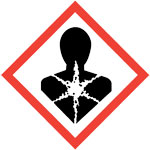 Health Hazard |
Respiratory sensitization: category 1 Germ cell mutagenicity: categories 1A, 1B, and 2 Carcinogenicity: categories 1A, 1B, and 2 Reproductive toxicity: categories 1A, 1B, and 2 Specific Target Organ Toxicity (Single exposure): categories 1 and 2 Specific Target Organ Toxicity (Repeated exposure): categories 1 and 2 Aspiration Hazard, category 1 |
03606 |
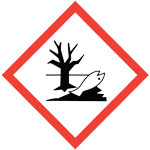 Environmental |
Hazardous to the aquatic environment (Acute hazard): category 1 Hazardous to the aquatic environment (Chronic hazard): categories 1 and 2 |
03607 |
Some pictograms take precedence over others. Per paragraph C.2.1 of Appendix C of the HazCom Standard:
C.2.1 Precedence of hazard information
C.2.1.1
If the signal word "Danger" is included, the signal word "Warning" shall not appear;
C.2.1.2
If the skull and crossbones pictogram is included, the exclamation mark pictogram shall not appear where it is used for acute toxicity;
C.2.1.3
If the corrosive pictogram is included, the exclamation mark pictogram shall not appear where it is used for skin or eye irritation;
C.2.1.4
If the health hazard pictogram is included for respiratory sensitization, the exclamation mark pictogram shall not appear where it is used for skin sensitization or for skin or eye irritation.
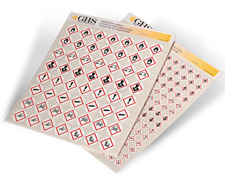
Get your GHS-compliant labels and signs from Safety Emporium.
See also: DOT, EINECS number, NSN and NIIN's, UN/NA numbers.
Additional definitions from Google and OneLook.
Entry last updated: Saturday, January 7, 2023. This page is copyright 2000-2025 by ILPI. Unauthorized duplication or posting on other web sites is expressly prohibited. Send suggestions, comments, and new entry desires (include the URL if applicable) to us by email.
Disclaimer: The information contained herein is believed to be true and accurate, however ILPI makes no guarantees concerning the veracity of any statement. Use of any information on this page is at the reader's own risk. ILPI strongly encourages the reader to consult the appropriate local, state and federal agencies concerning the matters discussed herein.